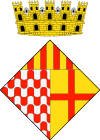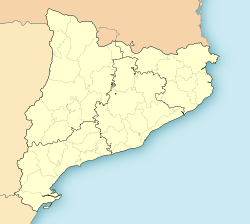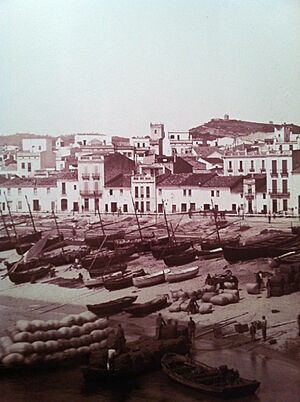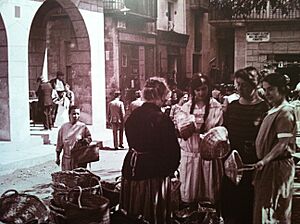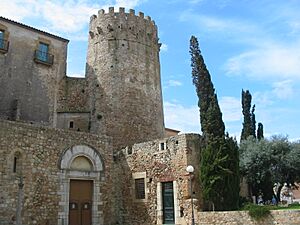Sant Feliu de Guíxols facts for kids
Quick facts for kids
Sant Feliu de Guíxols
|
|||
|---|---|---|---|
|
Municipality
|
|||
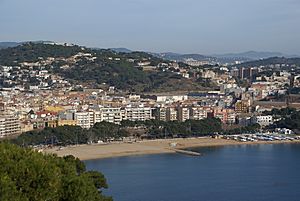 |
|||
|
|||
| Country | |||
| Community | |||
| Province | Girona | ||
| Comarca | Baix Empordà | ||
| Area | |||
| • Total | 16.2 km2 (6.3 sq mi) | ||
| Elevation | 4 m (13 ft) | ||
| Population
(2014)
|
|||
| • Total | 21,810 | ||
| • Density | 1,346/km2 (3,487/sq mi) | ||
| Demonym(s) | guixolenc/guixolenca, ganxó/ganxona | ||
Sant Feliu de Guíxols is a town located in the Baix Empordà area of Catalonia, Spain. It sits right on the beautiful Costa Brava coastline. This town is a busy port and a popular spot for tourists.
Just north of Sant Feliu de Guíxols, you'll find the fancy s'Agaró resort, built around Sant Pol Beach. Besides tourism and its port, Sant Feliu de Guíxols is also known for its traditional cork industry. The town has a large old monastery that is now a museum. It's a protected historical building.
You can reach Sant Feliu de Guíxols by road. The C-253 road goes north along the coast to towns like Platja d'Aro and Palamós. The C-65 road goes inland from the town. For amazing views, the GI-682 road offers a dramatic drive along the cliffs to Tossa de Mar in the south.
Sant Feliu de Guíxols is also a stop on the GR 92 long-distance walking path. This path stretches along the entire Mediterranean coast of Spain. If you walk north, Stage 9 follows the coast for about 16.8 kilometers to Palamós. If you walk south, Stage 10 goes mostly inland for about 20.2 kilometers to Tossa de Mar.
Contents
Geography and Climate of Sant Feliu
Sant Feliu de Guíxols is right on the Mediterranean Sea. Its coastline is over ten kilometers long! It has many small bays and coves hidden among pine trees. Some beaches are rocky, while others are sandy. The beaches are cleaned every day, and a modern water system keeps the sea clean from wastewater.
The town is surrounded by small mountains. These mountains are covered with forests of pine, oak, and cork trees.
Besides the main town, the area of Sant Feliu de Guíxols includes several smaller places:
- Bujonis
- El Vilar d'Aro
- Les Bateries
- Sant Amanç
- Sant Pol
- Mas Trempat
- Vilartagues
- la Casa Nova
- les Comes
What's in a Name? The Etymology
The name Sant Feliu comes from a saint named Felix of Girona. He was a martyr who died on August 31, 304 AD. He came from Carthage in North Africa.
The word Guíxols comes from an old word, iecsalis. This word was found in a document from the 900s that talked about the monastery. It seems to mean "rope-maker."
A Look Back in Time: History
People lived in this area a very long time ago, even in the 5th century BC. There was an Iberian settlement on a hill where the Salvament building is today.
Around the 1st century BC, people started moving down to the flat areas near the Riera de les Comes river. This is where the Monestir de Sant Feliu de Guíxols was built in the Middle Ages. The town grew around the monastery, with houses appearing on both sides of the river. This area became the center of the medieval town, especially around the market.
From 1892 to 1969, a narrow-gauge railway connected Sant Feliu de Guíxols to the city of Girona. This old railway line has now been turned into a greenway, which is a path for walking and cycling.
Famous Places and Buildings
Sant Feliu de Guíxols has many interesting places to see:
The Monastery of Sant Feliu de Guíxols
This is a very old and important building. It's called the Monestir de Sant Feliu de Guíxols. Today, it houses the town's museum.
Plaça del Mercat: The Market Square
The Plaça del Mercat is the main square and the heart of the town. It's where people gather and where a lot of the town's business happens. Every morning, you can find a fresh fruit and vegetable market here. On Sundays, a bigger weekly market takes place along the Passeig and in the Plaça. It's a popular meeting spot for everyone.
Passeig del Mar: The Seafront Promenade
The Passeig del Mar is a lovely walk along the sea. It was opened in 1833. This promenade was built between the old medieval town and the sea. Over time, the small homes of fishermen were replaced by grander houses. Today, many modern buildings stand here.
Casino la Constància
This beautiful building was built in 1888 by an architect named General Guitart. It's also known as Casino dels nois.
Pedralta: The Rocking Stone
Pedralta used to be the biggest rocking stone in Europe. A rocking stone is a large rock that is naturally balanced so it can be rocked with a small push.
Old Railway Station
The Old railway station was designed by Rafael Coderch and Gabriel March. It was built between 1889 and 1892. This station served the railway line that connected Sant Feliu de Guíxols to Girona until 1969. Now, it's used as a public school.
Historic Homes
In the late 1800s, Catalonia became very successful economically. This led to a wealthy middle class, called the bourgeoisie. Sant Feliu de Guíxols has many examples of their elegant homes from this time. Some of these beautiful houses include casa Gaziel (1880), casa Pecher (1894), casa Maynegre (1898), casa Girbau (1910), casa Maruny (1909), casa Ribot (1904), casa de la Campana (1911), and casa Patxot (1917).
The Town Hall
The town hall building has a simple, Gothic style. It was first built in 1547. It has survived many events over the centuries. A tower was added to it in 1847.
Hermitage of Sant Elm
This small chapel, called the Hermitage of Sant Elm, was first started in 1203. The chapel itself was built in 1452 and dedicated to Saint Elm. It was destroyed by the French in 1696 but rebuilt in 1723. It was damaged again in 1943 during the Spanish Civil War. The chapel you see today was restored in 1993. It sits high up on a cliff overlooking the sea.
El Corsari
El corsari is a unique bar that is built inside a cave.
Fun Events and Festivals
Sant Feliu de Guíxols is in an area famous for its parties, festivals, and especially its carnivals!
Porta Ferrada International Festival
The Porta Ferrada International Festival started in 1958. It takes place in the town's port area, usually in the summer. This festival features amazing theatre, music, and dance performances.
Festa Major
The Festa Major is a traditional Catalan festival. It's celebrated on August 1st and is dedicated to the town's patron saint, St. Feliu. The celebration includes a big fireworks show on the beach, which is always a highlight!
Sister Cities
Sant Feliu de Guíxols has special connections with other towns around the world. These are called "twin cities" or "sister cities."
 Schwaz, Austria
Schwaz, Austria Bourg-de-Péage, France
Bourg-de-Péage, France Mindelheim, Germany, since 1994
Mindelheim, Germany, since 1994 Verbania, Italy, since 1994
Verbania, Italy, since 1994 East Grinstead, England
East Grinstead, England
See also
In Spanish: San Felíu de Guixols para niños



